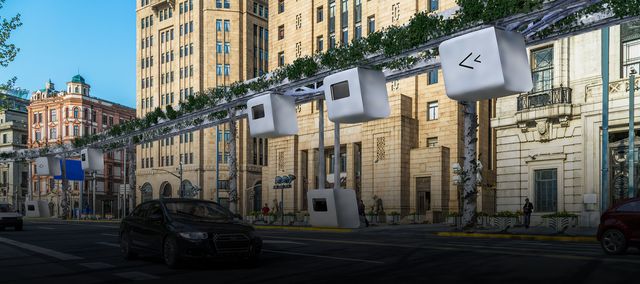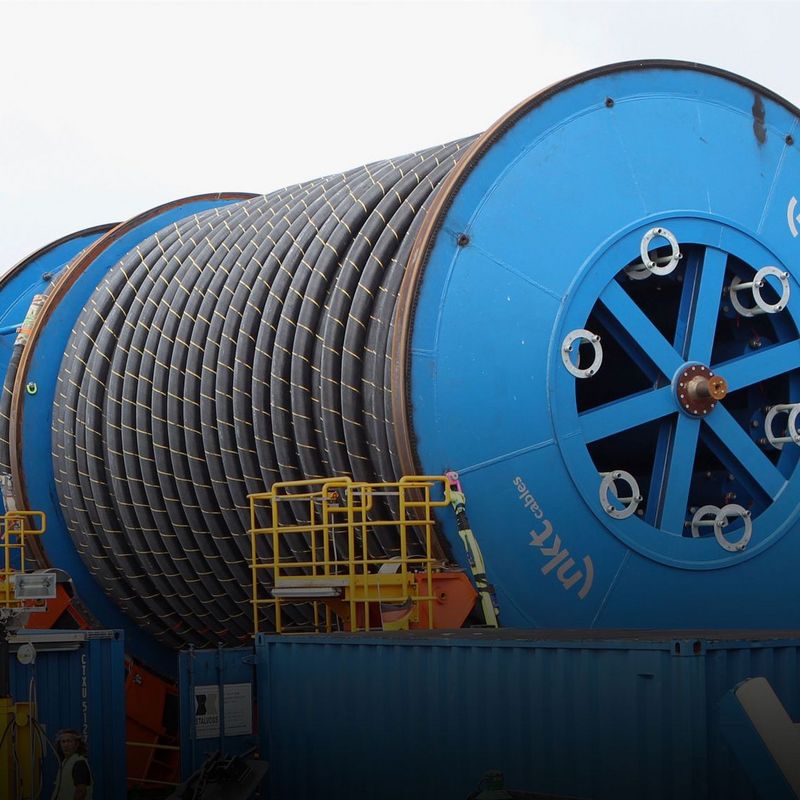14. Januar 2021
With electric cars, hydrogen-powered vehicles, self-driving cars and flying taxis, the propulsion and mobility systems that will define the transport sector of tomorrow already seem to be taking shape today. But other alternatives are also being worked on around the world. #explore presents three of them..
Vision 1: The flying car
“At some point we’re going to see a combination of a plane and car. You may laugh, but it will come," predicted the pontiff of car production, Henry Ford, the man who revolutionised vehicle production with his assembly lines, in 1940. The dream of the flying car is as old as the car itself. And since the very start, various ingenious inventors around the world have been working to make it into a reality. In October 2020, the PAL-V Liberty was one of the first vehicles of its kind to be granted approval – albeit initially only for road use. In this case, the Personal Air Landing Vehicle invented by Dutch company PAL-V can travel on three wheels at up to 160 kilometres per hour; through the air, it should be able to fly as a gyrocopter at 180 kilometres per hour at an altitude of up to 3,810 metres. The manufacturer expects the EU aviation safety authority (EASA) to complete its flight approval tests in 2022. PAL-V then hopes to to hand over the keys to its flying cars to the first customers.
Forbidding starting price
One thing’s for sure, however: the Dutch aircraft will not be landing on the mass market. The PAL-V Liberty is expected to cost 599,000 US dollars, and a later sports version is planned to go on sale at 399,000 dollars. Despite this forbidding price, the company claims to have 30 pre-orders in the Netherlands alone. Future customers will have to present a pilot’s licence in addition to their driving licence. However, in most countries, private pilots are only allowed to take off or land at airfields. The PAL-V Liberty, for its part, requires a 180-metre runway to take off. So, it follows that simply flying up and over traffic on the motorway or main roads is not an option for both technical and legal reasons. Whether the flying car actually offers advantages over today’s means of transport or will simply become an exotic hobby for the super-rich is therefore still open to question.
Complex compromise
For experts such as Stefan Levedag of the German Aerospace Center (DLR), although flying cars may be technically feasible, they represent a bad compromise rather than the best of both worlds. “They’re terrible cars and even worse aircraft,” says the head of the Institute of Flight Systems Technology at DLR. The experience of Terrafugia, a competitor of PAL-V, shows that even the development of a flying car is a turbulent affair. The US company presented the prototype of its “Transition” flying car as long ago as 2009. In 2012, it was granted preliminary approval by the US transportation authorities for use in the air and on the road. In the same year, the aircraft was scheduled for delivery to the first of its buyers. But even today – after various postponements, adjustments and further prototypes – not a single customer can boast a “Transition” in his or her garage. Terrafugia was acquired by Geely in 2017 and is developing an electric flying taxi for urban areas – a vision that clearly seems more promising to this Chinese car giant
© ddp images/Ferrari Press
Vision 2: The Hyperloop
Travelling by pneumatic tube: Shooting people or goods in transport capsules driven by magnets and turbines through airless tubes at up to 1,200 kilometres per hour – such is the idea behind the Hyperloop unveiled by Tesla CEO Elon Musk in a white paper in 2013. This professional visionary was convinced that it would one day be more environmentally friendly than travelling by plane and much cheaper than taking the train. Notwithstanding various doubts about Musk’s technological and financial assumptions, his concept has gained momentum and is being actively pursued by several companies.
A Hyperloop network through Europe
Dutch start-up Hardt has tested the technology in a 30-metre-long test tunnel and also developed a system that will allow lane changes without loss of speed. The capsules would not be tied to a single tube and route. The Dutch engineers are currently building a three-kilometre tunnel in Groningen, in which the capsules will also be tested at high speeds from 2022. The aim is to construct a European Hyperloop network covering a total of 10,000 kilometres. The start-up is working with companies including Tata Steel, Continental and Deutsche Bahn, which also has a stake in Hardt.
HyperloopTT is also hatching big plans. The Californian start-up is planning a 150-kilometre route between Abu Dhabi and Dubai, which is scheduled to start commercial operations as early as 2023. From the port of Hamburg, HyperloopTT intends one day to shoot shipping containers through its tubes into the interior of the country. In order to test its technology, the company has built a 320-metre-long test tunnel in Toulouse.
First passenger test ride
The greatest interim success in the race between the tube builders was, however, recorded by Virgin Hyperloop. In November 2020, Virgin founder and billionaire Richard Branson’s transport system completed its first test ride with passengers: Two Virgin Hyperloop managers sitting in a capsule reached a speed of 172 kilometres per hour. The company had previously conducted about 400 unmanned tests in the 10-kilometre-long test tube in Las Vegas, Nevada. Virgin Hyperloop plans to complete the development of the technology by 2025, with the first commercial trains expected to run five years later.
In the meantime, however, many technical and financial issues still need to be resolved. How can passengers be evacuated quickly and safely in the event of a fire? Can the capsules accelerate evenly enough to allow passengers to withstand their insane speed without fighter pilot training? How will the cabins be air-conditioned and supplied with oxygen? How can the enormous waste heat generated by the journey through airless space be safely diverted away? Will people even want to ride through tubes in windowless capsules? Can the Hyperloop really compete with existing transport systems in Europe?
From the developer’s point of view, the technical problems are there to be solved. Nothing can match the Hyperloop for efficiency, they say. However, as the German government established in its reply to a query from German Liberal party the FDP, there is as yet insufficient evidence to support this claim. It would take several years to develop and test the technology under real-world conditions. What’s more, it remains to be seen whether manufacturers can prove that the vacuum chambers are really suitable for passenger transport.
© mauritius images / Naeblys / Alamy
Vision 3: The Ottobahn
Ottobahn instead of “Autobahn” (the German for “motorway”): Cabins that bring passengers to their destination comfortably and with minimal environmental impact, without any need to change vehicle or wait – such is the vision with which a Munich start-up is seeking to revolutionise transport. The Ottobahn cabins will be able to stop anywhere on a permanently installed network of rails, wherever the passenger has ordered them by app. The self-driving gondolas can accommodate up to four passengers or two Euro pallets and are powered by an electric motor that picks up its charge from the rail. If you want to get off at your destination, a mechanism will power down the cabin. Stations or fixed stops will only be available at transport hubs or busy places, such as football stadiums.
Moving swiftly along at a height of five to ten metres should significantly reduce the strain on road traffic in and between cities. In urban areas, the gondolas will travel at up to 60 kilometres per hour, and over land, the idea is for them to reach speeds of up to 250 kilometres per hour in convoy – with a tenth of the energy that an electric car needs. Where an underground railway costs around 50 million euros per kilometre of track, one kilometre of Ottobahn can already theoretically be built for roughly five million euros. The roads and car parks that will be freed up by deploying this levitating railway system could be transformed into cycle paths or green spaces.
A new start for an old vision
The idea behind the Ottobahn is this: In transport planning, the principle is classified under the term “Personal Rapid Transit” (PRT) as a kind of public-private transport hybrid. Researchers have been seeking to make this vision a reality since the 1970s. In 1973, the test track for the so-called Cabinentaxi was inaugurated in Hagen with considerable fanfare. The dream was for automated, independently operating gondolas to take passengers to their destinations to order and without having to stop en route, thereby taking urban transport up to a new level. The plan was initially limited to Hagen itself, where a 132-kilometre rail network with 182 stations was planned, although Hamburg also initially signalled its interest. When funding expired at the end of the 1970s and not a single city could decide to implement it, the project was terminated, and the test track dismantled
© Ottobahn
Experts therefore tend to believe that the Ottobahn will be most likely to take off in those urban environments which don’t have a transport concept in the first place: for example in China, where new cities are shooting out of the ground at dizzying speed. The Ottobahn makers are not averse to launching their product abroad. They are already in contact with privately funded projects in Asia and the US. But their gondola system is also under discussion at their headquarters in Munich – as an alternative to a planned cable car connection between Dachau and the Munich district of Moosach or for a route along the A8. During a visit in November 2020, local politicians were impressed by the technology. However, despite all the enthusiasm, it would be crucial “for the company to get the system to market maturity” stressed Helmut Zech, deputy district councillor for the Dachau district. The Ottobahn team is convinced that the technology can be ready for series production within a year. A first line could be installed and put into operation by mid-2024. Between now and then, however, the Ottobahn builders will also have to show how people will be able to embark or disembark on open roads without blocking traffic along or beneath the rails





